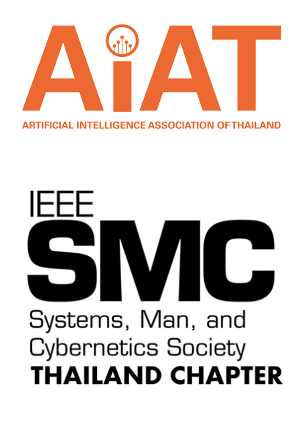A FCD–based Method for Traffic Congestion Detection in low-proximity data environment
DOI:
https://doi.org/10.14456/jiist.2017.3Keywords:
Intelligent Transportation Systems, Artificial Neural Networks, Pattern Recognition Traffic Congestion Detection, Expectation Maximization, Gaussian Mixture ModelsAbstract
Recently GPS data gathered from vehicles on roads, so-called floating car data (FCD), have become one of the popular sources for traffic management. As this source of data becomes more accessible, there are increasing research works conducted in order to extract reliable information from available raw sensory data. Such data from public transportation equipped with GPS sensors provides relatively consistent source of FCD. However, in some cases, due to low-frequency travel routines and the small number of active vehicles, extracted FCD are not sufficient for traffic prediction. This study proposes a method to efficiently identify road congestion using FCD collected from in-campus shuttle buses in low speed routes. In this task, the challenging issue is how to distinguish real congestion from intentional delay, such as passenger loading and temporary parking, since both are similar in terms of low average speed on the road link. The proposed method employs artificial neural network to predict traffic on the links with sparse FCD available. The experimental result demonstrates that our method is capable of producing comparable results with existing methods.
References
Ashbrook, Daniel, and Thad Starner. "Learning significant locations and predicting user movement with GPS." In Wearable Computers, 2002.(ISWC 2002). Proceedings. Sixth International Symposium on, pp. 101-108. IEEE, 2002.
Leduc, Guillaume. "Road traffic data: Collection methods and applications." Working Papers on Energy, Transport and Climate Change 1 (2008): 55.
Long Cheu, Ruey, Chi Xie, and Der‐Horng Lee. "Probe vehicle population and sample size for arterial speed estimation." Computer‐Aided Civil and Infrastructure Engineering 17, no. 1 (2002): 53-60.
Hong, Jun, Xuedan Zhang, Zhongya Wei, Li Li, and Yong Ren. "Spatial and temporal analysis of probe vehicle-based sampling for real-time traffic information system." In Intelligent Vehicles Symposium, 2007 IEEE, pp. 1234-1239. IEEE, 2007.
Li, Dapeng, Yu Haitao, Xiaohua Zhou, and Mengdan Gao: Map-reduce for calibrating massive bus trajectory data. In: ITS Telecommunications (ITST), 2013 13th International Conference on, pp. 44-49. IEEE, 2013.
Weijermars, Wilhelmina Adriana Maria. Analysis of urban traffic patterns using clustering. University of Twente, 2007.
Ashbrook, Daniel, and Thad Starner. "Learning significant locations and predicting user movement with GPS." In Wearable Computers, 2002.(ISWC 2002). Proceedings. Sixth International Symposium on, pp. 101-108. IEEE, 2002.
Wu, Xueying, and Chunlong Yao. "Application of improved K-means clustering algorithm in transit data collection." In Biomedical Engineering and Informatics (BMEI), 2010 3rd International Conference on, vol. 7, pp. 3028-3030. IEEE, 2010.
Modsching, Marko, Ronny Kramer, and Klaus ten Hagen. "Field trial on GPS Accuracy in a medium size city: The influence of built-up." In 3rd Workshop on Positioning, Navigation and Communication, pp. 209-218. 2006.
Abadi, Afshin, Tooraj Rajabioun, and Petros Ioannou. "Traffic flow prediction for road transportation networks with limited traffic data." Intelligent Transportation Systems, IEEE Transactions on 16, no. 2 (2015): 653-662.
Lipan, Florin, and Adrian Groza. "Mining traffic patterns from public transportation GPS data." In Proceedings of the 2010 IEEE 6th International Conference on Intelligent Computer Communication and Processing, pp. 123-126. IEEE, 2010.
Zhu, Tongyu, Jian Dong, Jian Huang, Songsong Pang, and Bowen Du. "The bus arrival time service based on dynamic traffic information." In Application of Information and Communication Technologies (AICT), 2012 6th International Conference on, pp. 1-6. IEEE, 2012.
Cheng, Shaowu, Baoyi Liu, and Botao Zhai. "Bus arrival time prediction model based on APC data." (2010): 165-169.
Jeong, Ranhee, and Laurence R. Rilett. "Bus arrival time prediction using artificial neural network model." In Intelligent Transportation Systems, 2004. Proceedings. The 7th International IEEE Conference on, pp. 988-993. IEEE, 2004.
Bin, Yu, Yang Zhongzhen, and Yao Baozhen. "Bus arrival time prediction using support vector machines." Journal of Intelligent Transportation Systems 10, no. 4 (2006): 151-158.
De Fabritiis, Corrado, Roberto Ragona, and Gaetano Valenti. "Traffic estimation and prediction based on real time floating car data." In Intelligent Transportation Systems, 2008. ITSC 2008. 11th International IEEE Conference on, pp. 197-203. IEEE, 2008.
Kerner, B. S., C. Demir, R. G. Herrtwich, S. L. Klenov, H. Rehborn, and A. Haug. "Traffic state detection with floating car data in road networks." In Intelligent Transportation Systems, 2005. Proceedings. 2005 IEEE, pp. 44-49. IEEE, 2005.
Ho, Yao Hua, Yao Chuan Wu, Meng Chang Chen, TsunJui Wen, and Yeali S. Sun. "GPS Data Based Urban Guidance." In Advances in Social Networks Analysis and Mining (ASONAM), 2011 International Conference on, pp. 703-708. IEEE, 2011.
Poomrittigul, Suvit, Setha Pan-ngum, Kunchit Phiu-Nual, Wasan Pattara-atikom, and Panita Pongpaibool. "Mean travel speed estimation using GPS data without ID number on inner city road." In ITS Telecommunications, 2008.
ITST 2008. 8th In-ternational Conference on, pp. 56-61. IEEE, 2008.
The Weather Underground, LLC., http://www.wunderground.com/history/
Bentley, Jon Louis. "Multidimensional binary search trees used for associative searching." Communications of the ACM 18, no. 9 (1975): 509-517.
Moon, Tood K. "The expectation-maximization algorithm." Signal processing magazine, IEEE 13, no. 6 (1996): 47-60.




